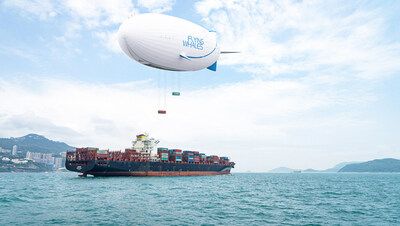Flying Whales, which is developing a new LCA60T hybrid airship in Canada, has announced that Honeywell’s new purpose-built one megawatt aviation generator will power the aircraft. The Quebec-based company is building a rigid airship buoyed by 180,000 cubic meters of helium that the company says can lift and carry 132,000 pounds. It will have electric motors for propulsion, and that’s where the lightweight turbine-powered generator comes in.
“Honeywell’s one megawatt generator is a perfect fit for a transformational aircraft like the LCA60T,” said Dave Marinick, president, Engines & Power Systems, Honeywell Aerospace. “Our generator is four times as powerful as any other generator flying today, and at unmatched power density. We believe in creating a more sustainable future for aviation, and our work with FLYING WHALES is helping bring that future to life.” The first flight of the airship is slated for the end of the 2025 and the company sees roles in mining, remote community cargo and humanitarian relief among its potential markets.




































Thought the first flight was meant to take place this year in France?
If not it will upset the French govt, which has invested a lot of the €112 million (and counting) for the company to get this far — and the French regional governments which have given the company virtually rent free factory land for the first couple of years.
My understanding is that Quebec (not Canada) put up some of the stump money but has let its stake be diluted by not taking part much in further funding.
Funny too that forestry, which is the reason for being for the project in Europe, has faded from the US communiques. From what I have seen it is about the only job where using an airship will have less environmental impact than land transport.
I truly believe that ‘Onboard Generators’ are the future to more efficient transportation. Trains have been doing it for decades and now generators are smaller, lighter and more efficient then ever. Battery development has hit a wall in development but micro-generator technology has only begun.
Look at what these guys are doing: https://www.liquidpiston.com/
Agreed.
Batteries are a dead end in aviation due to weight, size, recharging, and fire issues. A piston or turbine power source makes some sense. Again like a diesel electric locomotive, or modern large ships with thruster motors.
But of course the question is, why not just use the engine to propel the craft without the added weight and complexity of the generator, power management systems, and electric motors.
Probably because you need multiple thrusters, and it trades off as being more weight and complexity efficient to have a single generator feeding distributed electric motors.
Maybe not a single generator. It might be worth having two onboard.
More and more aviation is heading to ‘Vertical take-off and landing capable’. Just like those bow thrusters on a ship the Vertical Thrusters on the future aircraft will most likely be electric motors. I’m totally into an add-on Vertical kit for a Cub that allows it to operate like a helicopter 😎 .
They have that already.
Its called the Carbon Cub 😉
Thumbs up.
Hehe
If nothing else, all this electric aircraft research has led to some impressively light electric motors & generators. The 1MW (~1300 hp) generator discussed here is said to weigh only 280 lb., although I assume this doesn’t include the drive engine & any required cooling system. Still, if you need distributed power for multiple thrusters it certainly start to make sense.
Iy is a turbogenerator, which can run on biofuel. It is a turnkey power supply.
From aerospace.honeywell.com/us/en/about-us/press-release/2022/05/honeywell-megawatt-generator-achieves-milestone:
“These turbogenerator solutions can provide electricity to operate high-power electric motors, charge batteries, or in required cases mechanically drive a propeller to satisfy missions from heavy-lift cargo drones to air taxis and commuter aircraft.
“
The airship concept is nothing new – Popular Mechanics was running articles on this design over 30 years ago. What is new is the electric propulsion systems that might actually make it practical. Still seems like a solution in search of a problem, though. Considering how much the cost of helium has gone up in the meantime, due to a looming major shortage of the gas, the economics of the idea may not be as attractive today. 180,000 cubic meters cannot be cheap!